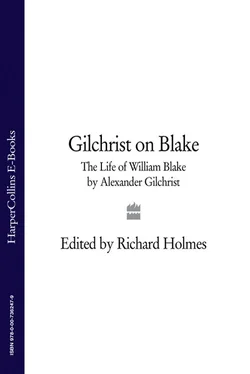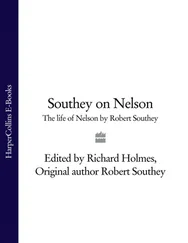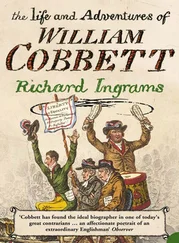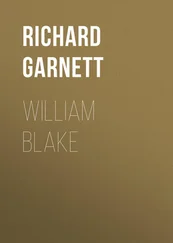Then, thirteen years later, on 1 November 1860, Rossetti wrote to his friend the poet William Allingham with surprising news. ‘A man (one Gilchrist, who lives next door to Carlyle) wrote to me the other day, saying he was writing a Life of Blake, and wanted to see my manuscript by that genius. Was there not some talk of your doing something by way of publishing its contents? I know William thought of doing so, but fancy it might wait long for his efforts…I have not engaged myself in any way to the said Gilchrist on the subject, though I have told him he can see it here if he will give me a day’s notice.’
When the ‘said Gilchrist’ finally visited in March 1861, Rossetti was surprised to encounter a long-haired, dreamy, moon-faced young man who looked rather as if he had stepped out of one of his own Pre-Raphaelite paintings. Alexander Gilchrist was thirty-two, a young writer and art critic, who announced quietly that he had been working on a Life of Blake for the last six years. Indeed, he had already signed a contract with the publisher Macmillan. He did not think William Blake was mad; in fact he thought he was a genius. He was going to transform his reputation, however long it took him, and whatever it cost him.
Who was Blake’s unexpected champion? Born in the year after Blake’s death in 1828, Alexander Gilchrist had trained as a barrister in the Middle Temple. Restless in his profession, bookish and not physically strong, but with great determination and independence of mind, Gilchrist sought freedom in magazine journalism and freelance art criticism. From 1849, when he was just twenty-one, he began to write regularly for the Eclectic Review , and quickly made his name as critic and reviewer. He was known for his fresh eye, his jaunty prose style, his meticulous background research, and his highly unorthodox views. He was also a young critic in search of a cause.
In 1850, he produced an outstanding article on the forgotten and unfashionable painter, William Etty. Etty had once been renouned as an exuberant painter of Romantic nudes, both male and female, and erotic scenes from classical history and mythology, such as his Vision of Gyges. Once admired by Regency critics, Victorian taste and propriety had turned against him, and his paintings were scoffingly referred to in Academy circles as ‘Etty’s bumboats’. Gilchrist accepted a speculative commission from a provincial publisher, David Bogue, to write a full-length biography. He undertook to re-establish Etty’s reputation, and turn back the tide of priggish mockery and misunderstanding.
On the strength of the £100 commission, Alexander married his twenty-three year old sweetheart, Anne Burrows, in February 1851. They spent part of their honeymoon researching Etty’s life in York, where the painter had lived and worked. They interviewed his friends, and examined his nude studies and historical pictures, now mostly housed in private collections. This unorthodox nuptial expedition greatly appealed to Anne, who was freethinking in her views, and impatient with the conventions of her respectable Highgate upbringing. She too hoped one day to write.
Their first child was born in December 1851, and the large Etty biography was published in 1855, when Gilchrist was still only twenty-seven. The book, which was studiously written and safely deprived of all illustrations (apparently Bogue lost his nerve at the last moment), caused only a mild scandal in York. But in London it drew wholly unexpected praised from the sixty year-old doyen of biographical writing, Thomas Carlyle. It was written, the Sage announced, ‘in a vigorous, sympathetic, vivacious spirit’, and gave the ‘delineation, actual and intelligible, of a man extremely well-worth knowing’. This rare mark of approval from the author of On Heroes, Hero-Worship and the Heroic in History (1841), confirmed Gilchrist in his new vocation as biographer.
After several visits to Chelsea, Gilchrist established himself as Carlyle’s confidante and to some extent his biographical protege. The Sage had recently published his influential Life of John Sterling (1851), which by sympathetically recounting the career of an apparent failure, indeed a kind of anti-Hero, gave the whole genre a new impulse. It was a time when biography was about to enter a new literary golden age, with John Forster’s Oliver Goldsmith (1854), Mrs Gaskell’s Charlotte Bronte (1857), Samuel Smiles’s Self-Help (1859), G. H. Lewes’s Goethe (1855) and Frederick Martin’s John Clare (1866).
Carlyle noticed that Gilchrist’s dreamy appearance was deceptive: the young lawyer had a capacity for relentless archival research, an almost forensic gift for tracking down rare books and documents. Carlyle was working, with many groans, on his multi-volume Life of Frederick the Great , and soon found Gilchrist bringing him numerous rare bibliographic finds. ‘Beyond doubt you are one of the successfullest hunters up of Old Books now living,’ beamed Carlyle, ‘and one of the politest of obliging men!’
The bookish Gilchrist also took great delight in pursing his open-air researches. With Anne he took long walks in Kent, Dorset, and the Lake District. With Carlyle he wandered after midnight about the backstreets of Westminster, Soho, Lambeth or the City. He had an eye (not unlike the young Dickens) for old houses, forgotten buildings, crooked corners, and disappearing communities. Faced with some old church, said Anne, he would ‘scan every stone’ until it yielded up its ‘quota of history’. Over long evenings of black tea and tobacco, Carlyle encouraged him to talk, speculate, and seek a daring new subject for his pen. A warm, if slightly wary, friendship also grew up between Anne and the older Jane Carlyle.
The subject of William Blake had probably been in Gilchrist’s mind for more than a decade. As a young law student of the Middle Temple, Gilchrist had heard rumours of Blake as the eccentric erstwhile occupant of Fountain Court, which he passed through every day on the way to his legal chambers. He wrote a highly characteristic evocation of this place, its sacred Blakean associations overlaid by mid-Victorian seediness, that eventually appeared in Chapter 31 of his biography.
Fountain Court, unknown by name, perhaps, to many who yet often pass it on their way through a great London artery, is a court lying a little out of the Strand, between it and the river, and approached by a dark narrow opening, or inclined plane, at the corner of Simpson’s Tavern, and nearly opposite Exeter Hall. At one corner of the court, nearest the Strand, stands the Coal Hole Tavern, once the haunt of Edmund Kean and his ‘Wolf Club’ of claquers , still in Blake’s time a resort of the Thespian race; not then promoted to the less admirable notoriety it has, in our days, enjoyed. Now the shrill tinkle of a dilapidate piano, accompaniment to a series of tawdry poses plastiques , wakes the nocturnal echoes, making night hideous in the quiet court where the poet and visionary once lived and designed the Inventions of Job.
Initially Gilchrist knew little of the poetry. As an art critic it was a copy of Blake’s Illustrations to the Book of Job , found at the back of a London printshop, which first caught his eye. He never lost his sense of their astonishing power, and it was Blake’s visual imagination which always remained for Gilchrist the key to his genius. Accordingly, in summer 1855 he decided to write to one of the surviving Ancients, the painter Samuel Palmer, by then aged sixty.
On 23 August 1855 Gilchrist received a long and engaging reply, which he later reprinted entire in Chapter 33 of his biography. While praising Blake’s artistic integrity, Palmer carefully dispelled the notion of Blake’s madness, and replaced it with the figure of a gentle, almost Christ-like sage. ‘He was a man without a mask; his aim was single, his path straight-forwards, and his wants few…His voice and manner were quiet, yet all awake with intellect…He was gentle and affectionate, loving to be with little children, and to talk about them. That is heaven,’ he said to a friend, leading him to a window, and pointing to a group of them at play.’
Читать дальше












